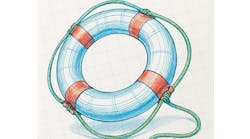By now nearly all of us have some measure of awareness and tolerance—or lack thereof—for the tracking capabilities of our smartphones, web browsers and digital assistants. And if you haven’t heard a story of search results or web advertisements relevant to an “overheard” conversation—whether by Alexa, Google Assistant, or just the phone itself—I think you’ve been off the grid for a while. The tracking is worrisome for many who’ve read George Orwell's novels and imagine the information in the hands of a nefarious authoritarian regime. While others simply hope for security through obscurity: “Yes, Amazon knows I’m in the market for a new mattress, but I’m so boring, so who would care?”
Today, if you’re driving an automobile in the U.S., you’ve seen plenty of ads and maybe even your insurance agent has encouraged you to take advantage of a special discount: just let them track your driving. I finally relented when my rates went sky-high last year. You download their app, which knows if you’re talking on your phone or texting while driving (very bad), or if you’re braking hard, or cornering at excessive speed. You can check if you’ve received gold stars or frowny faces, and the very staid driver (as judged via the app) can potentially earn even greater discounts. We may not be TikTok stars or Instagram celebs, but the insurance man finds us pretty interesting. It makes one ponder—why wouldn’t this become a compelling model for the underwriters who insure our process plants? Or OSHA? Or the EPA?
If you're on the edge of digitalization, you're theoretically gathering and cataloging all manner of useful intelligence from your equipment and devices. It has the potential to reflect on the plant’s adherence to PMs (preventive maintenance, sometimes known as recreational maintenance), how rapidly equipment is repaired (and even the efficacy of those repairs), critical instrument calibrations, alarm and interlock testing, what interlocks are in bypass (and for how long), and so on. Since most plants these days are staffed to run, we lack a data scientist onsite to make use of all that information. Instead, it’s become fashionable to engage in some cloud services from one’s historian vendor or data analytics provider. Imagine, your control valve vendor offers to monitor the health of your critical valves, and it’s just a few mouse-clicks to grant them the access they need.
Fast-forward a few years and nearly all the boomers hired in the ‘70s and ‘80s will have moved on, along with their experience and tacit knowledge. Their heirs that remain encounter some issues with unforeseen equipment outages, permit violations or more dire calamities. The bare-bones and technically decimated corporate staff can offer little beyond complaints and criticism, and the underwriters are quoting ever-higher premiums, fearing an extended outage is likely. Imagine a particularly unfortunate and bedraggled facility under threat of an enormous increase in premiums—or having its coverage dropped altogether.
Auditors rely on audits and reporting to derive their assessment of a plant’s compliance, and frequently the incriminating evidence is mined from the plant’s own records. But our underwriters also would struggle—I’d speculate—to make sense of our raw data. Either they add the expertise to interpret it, or they engage with our automation suppliers to do the diagnostics or forensics on their behalf. If individual facilities defer the investment to utilize device intelligence and diagnostics, what if the insurer steps in and says, “We find these data and analytics useful”? A similar case could be made for cybersecurity: if we don’t do it for ourselves, a third party could become our Big Brother.
Our operators detest management looking over their shoulder whether they’re at the DCS console or in the field. In a similar vein, I've yet to meet a plant manager who enjoyed anyone backseat driving from beyond the plant’s fence line. But will corporate neglect of succession planning and knowledge transfer—leaving the more youthful to fend for themselves—lead to a future where many past mistakes are repeated? In an increasingly risk-averse new world, we might be the ones who hand the keys over to our new overseers.






